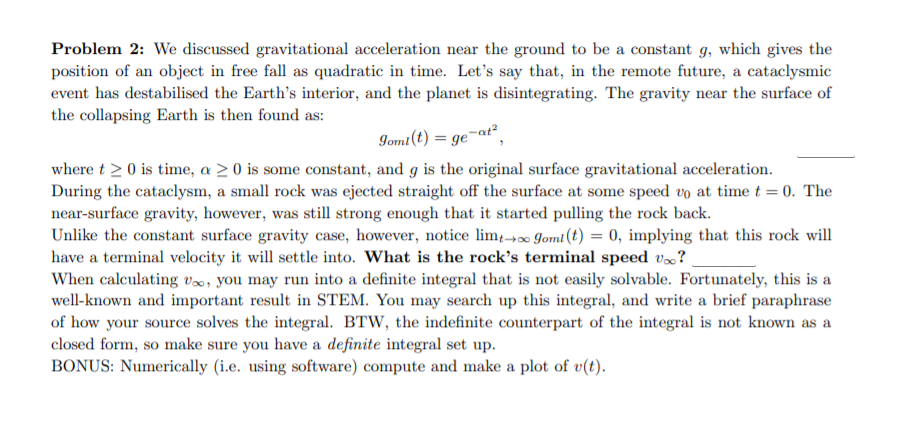Problem 2: We discussed gravitational acceleration near the ground to be a constant g, which gives the position of an object in free fall as quadratic in time. Let's say that, in the remote future, a cataclysmic event has destabilised the Earth's interior, and the planet is disintegrating. The gravity near the surface of the collapsing Earth is then found as: Iomt (t) = ge¬at² where t > 0 is time, a 2 0 is some constant, and g is the original surface gravitational acceleration. During the cataclysm, a small rock was ejected straight off the surface at some speed vo at time t = 0. The near-surface gravity, however, was still strong enough that it started pulling the rock back. Unlike the constant surface gravity case, however, notice lim-∞ Gomt (t) = 0, implying that this rock will have a terminal velocity it will settle into. What is the rock's terminal speed v»? When calculating væ, you may run into a definite integral that is not easily solvable. Fortunately, this is a well-known and important result in STEM. You may search up this integral, and write a brief paraphrase of how your source solves the integral. BTW, the indefinite counterpart of the integral is not known as a closed form, so make sure you have a definite integral set up.
Problem 2: We discussed gravitational acceleration near the ground to be a constant g, which gives the position of an object in free fall as quadratic in time. Let's say that, in the remote future, a cataclysmic event has destabilised the Earth's interior, and the planet is disintegrating. The gravity near the surface of the collapsing Earth is then found as: Iomt (t) = ge¬at² where t > 0 is time, a 2 0 is some constant, and g is the original surface gravitational acceleration. During the cataclysm, a small rock was ejected straight off the surface at some speed vo at time t = 0. The near-surface gravity, however, was still strong enough that it started pulling the rock back. Unlike the constant surface gravity case, however, notice lim-∞ Gomt (t) = 0, implying that this rock will have a terminal velocity it will settle into. What is the rock's terminal speed v»? When calculating væ, you may run into a definite integral that is not easily solvable. Fortunately, this is a well-known and important result in STEM. You may search up this integral, and write a brief paraphrase of how your source solves the integral. BTW, the indefinite counterpart of the integral is not known as a closed form, so make sure you have a definite integral set up.
Classical Dynamics of Particles and Systems
5th Edition
ISBN:9780534408961
Author:Stephen T. Thornton, Jerry B. Marion
Publisher:Stephen T. Thornton, Jerry B. Marion
Chapter10: Motion In A Noninertial Reference Frame
Section: Chapter Questions
Problem 10.12P
Related questions
Question
Need help with prob 2. Please show your work and box your answer
thank you

Transcribed Image Text:Problem 2: We discussed gravitational acceleration near the ground to be a constant g, which gives the
position of an object in free fall as quadratic in time. Let's say that, in the remote future, a cataclysmic
event has destabilised the Earth's interior, and the planet is disintegrating. The gravity near the surface of
the collapsing Earth is then found as:
Iomt(t) = ge¬at²,
where t > 0 is time, a > 0 is some constant, and g is the original surface gravitational acceleration.
During the cataclysm, a small rock was ejected straight off the surface at some speed vo at time t = 0. The
near-surface gravity, however, was still strong enough that it started pulling the rock back.
Unlike the constant surface gravity case, however, notice lim→∞0 Jomt (t) = 0, implying that this rock will
have a terminal velocity it will settle into. What is the rock's terminal speed v»?
When calculating v0, you may run into a definite integral that is not easily solvable. Fortunately, this is a
well-known and important result in STEM. You may search up this integral, and write a brief paraphrase
of how your source solves the integral. BTW, the indefinite counterpart of the integral is not known as a
closed form, so make sure you have a definite integral set up.
BONUS: Numerically (i.e. using software) compute and make a plot of v(t).
Expert Solution
This question has been solved!
Explore an expertly crafted, step-by-step solution for a thorough understanding of key concepts.
This is a popular solution!
Trending now
This is a popular solution!
Step by step
Solved in 3 steps with 3 images

Knowledge Booster
Learn more about
Need a deep-dive on the concept behind this application? Look no further. Learn more about this topic, physics and related others by exploring similar questions and additional content below.Recommended textbooks for you

Classical Dynamics of Particles and Systems
Physics
ISBN:
9780534408961
Author:
Stephen T. Thornton, Jerry B. Marion
Publisher:
Cengage Learning

Principles of Physics: A Calculus-Based Text
Physics
ISBN:
9781133104261
Author:
Raymond A. Serway, John W. Jewett
Publisher:
Cengage Learning

University Physics Volume 3
Physics
ISBN:
9781938168185
Author:
William Moebs, Jeff Sanny
Publisher:
OpenStax

Classical Dynamics of Particles and Systems
Physics
ISBN:
9780534408961
Author:
Stephen T. Thornton, Jerry B. Marion
Publisher:
Cengage Learning

Principles of Physics: A Calculus-Based Text
Physics
ISBN:
9781133104261
Author:
Raymond A. Serway, John W. Jewett
Publisher:
Cengage Learning

University Physics Volume 3
Physics
ISBN:
9781938168185
Author:
William Moebs, Jeff Sanny
Publisher:
OpenStax